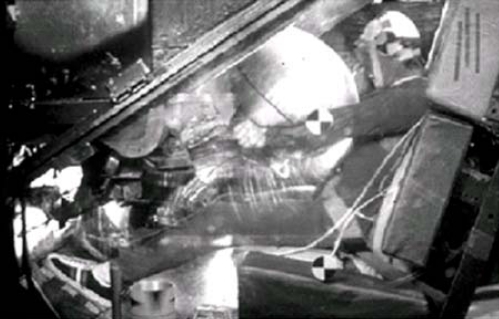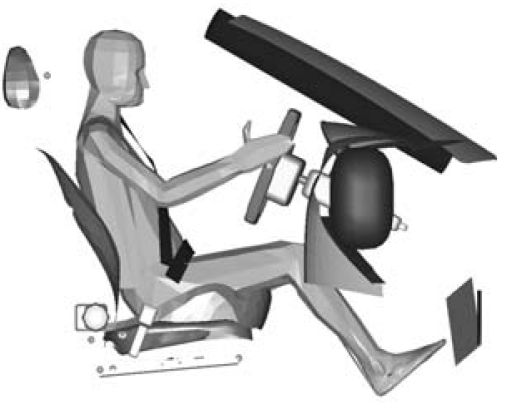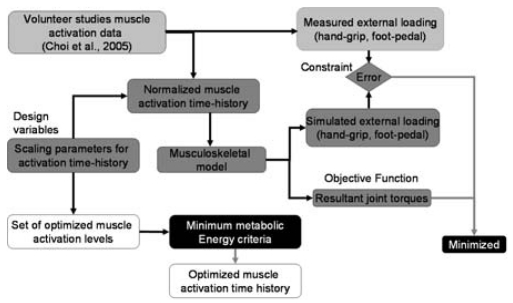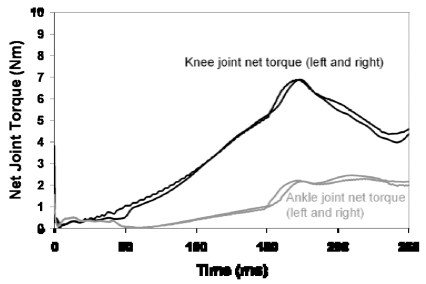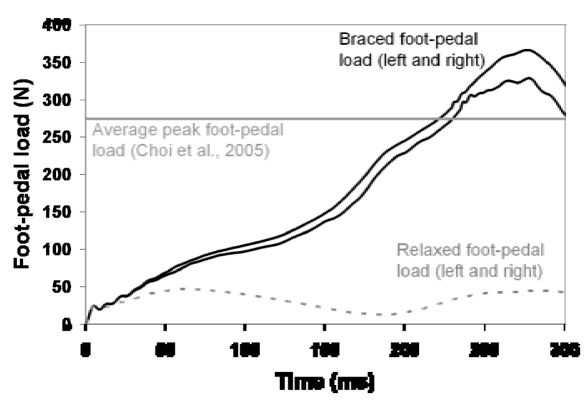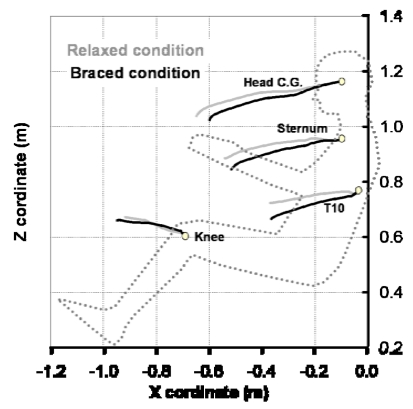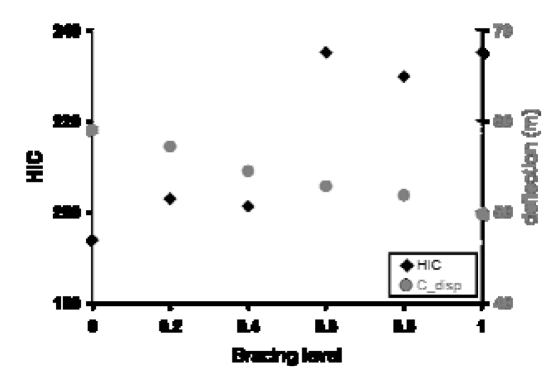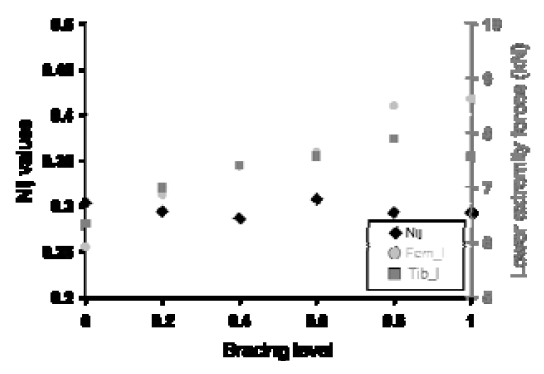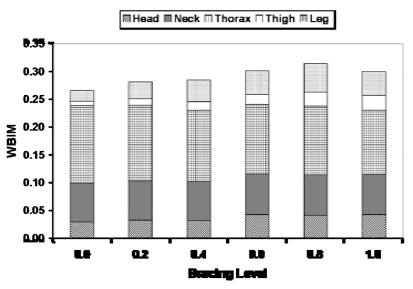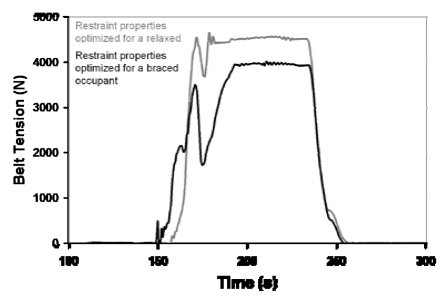Abstract
Optimal performance of adaptive restraint systems requires an accurate assessment of occupant parameters including physical properties and pre-collision behavior of the occupant. Muscle bracing, one of the key reflexive actions adopted by car occupants to mitigate the severity of an impending collision, is ignored in restraint designing since conventional human surrogate tools used for injury assessment due to collision loading provide limited insight into this effect. This study is aimed at evaluating the effect of pre-collision muscle bracing on the injury outcome of an occupant using a simplified numerical musculoskeletal model. The activation levels for 12 major muscle groups loading the ankle, knee, hip and elbow joints, were determined using an optimization routine with data collected from previously reported volunteer sled tests. A whole body injury metric, weighted to the severity of injury and the injured body region, was used to evaluate the potential risk of injuries estimated for different levels of bracing. The musculoskeletal model was further used to determine the requirements on the restraint system properties to minimize overall injuries for an occupant in a relaxed and a braced condition. Significant variation was observed in the load-limiting value and pre-tensioner firing time, as the restraint properties were optimized to account for the bracing behavior. The results of the study provide a framework for improving the performance of adaptive restraint systems, currently designed for passive anthropometric tests devices, by taking into account realistic response of the occupant involved in a collision.
INTRODUCTION
Future efforts in vehicle design must be directed towards optimizing restraint and safety devices to account for individual occupant response and collision characteristics. However, current designing of restraint systems is primarily motivated by federal compliance tests and car assessment programs, which only partially address the variation in anthropometric sizes of the occupant [NHTSA, 2004]. Besides anthropometric size, pre-collision behavior such as bracing or muscle tension is expected to influence the occupant dynamics during a collision. Studies involving low-speed volunteer sled tests, driving simulator tests, and numerically simulated bracing behavior, have reported significant differences in occupant kinematics and distribution of energy due to the muscle forces generated in a pre-collision environment [Begeman et al., 1980; Choi et al., 2005; Ejima et al., 2005; Manning et al., 1997]. While studies have indicated that bracing alters the occupant dynamics prior to a collision, the effect of pre-collision bracing on the injuries sustained during a collision is largely unreported since conventional tools such as human cadavers, anthropometric test devices, and volunteer tests within non-injurious thresholds provide limited insight to the influence of muscle tension. Given the fact that at least half of all occupants engage in emergency bracing prior to a frontal collision [Ore, 1992], the lack of musculoskeletal response as a design parameters for adaptive restraint systems could undermine their effectiveness in mitigating collision induced injuries for the overall population.
Several volunteer studies have been performed to estimate the magnitude of pre-impact bracing and its consequences for hypothesized injury mechanisms, and injury threshold values. Armstrong et al., (1968) evaluated the effectiveness of upper and lower extremities as propriotonic restraints using results from high deceleration (15 g) volunteer sled tests. The study reported that for an occupant restrained by a three-point belt system, 44% of the total kinetic energy of the decelerating vehicle was transferred to the lower extremities of the occupant, which was comparable to the portion of the total kinetic energy transferred to the belt system (41 %). Although the lower extremities proved to be effective energy management systems, the magnitude of foot forces measured for braced volunteers were in the range of 1kN to 2kN [Begeman et al., 1980], which when coupled with inertial forces can potentially cause lower extremity injuries even in moderate speed crashes. For instance, using the values of peak foot pedal forces generated by volunteers in driving simulator studies, Manning et al. (1997) evaluated the tensile force in the Achilles tendon to be in the range of 1.5 kN to 2 kN, which is approximately 25% of tolerance limit for axial compression loading of the tibia [Funk et al., 2001].
Compared to the number of studies reporting the effect of bracing on lower extremity load transmission, fewer studies have highlighted the effect of bracing on overall occupant kinematics and injuries. Ejima et al. (2005) reported on the activation of different muscle groups in conjunction with overall body segment kinematics measured during low speed (0.2g to 1 g) volunteer sled tests. The kinematic results derived from motion sensors attached to the volunteer body indicated an approximate difference of 200 mm and 50 mm in the excursion of head and T10 vertebrae, respectively, between a braced and a relaxed volunteer subjected to 1g deceleration. Choi et al., (2005) performed volunteer sled test and reported on experimentally measured electromyography (EMG) for major muscle groups. The estimated muscle activation levels were used as an input to a musculoskeletal model to evaluate the differences in whole body dynamics due to muscle bracing. The findings of the volunteer and driving simulator studies suggest that magnitude of muscle forces developed through bracing behavior are capable of altering the pre-collision posture of the occupant in addition to pre-loading the joints and long bones of the body.
Although experimental and numerical studies have emphasized the effects of muscle bracing on whole-body dynamics, the consequences of the bracing behavior on the restraint performance or collision induced injuries is rarely reported in the literature. Based on the occupant kinematics reported in a study involving braced volunteers (Figure 1), the authors suspect that the maximum allowable excursion distance for the application of restraining force is altered due to kinematic changes in the upper body attributed to muscle bracing. The current study is aimed at evaluating the influence of active muscle bracing on the injury response of an occupant in frontal collisions, using the following two objectives,
Figure 1.
Overall kinematics of a braced volunteer in a high-speed (48 km/h) frontal sled test [Crandall et al., 2003]
To evaluate the sensitivity of injury severity and distribution sustained by an occupant in a collision to the level of pre-collision bracing.
To analyze the performance of restraint systems optimized for the passive response of human occupants, in cases where the occupant characteristics are altered due to active muscle tension.
The sensitivity of optimized restraint parameters to varying levels of pre-collision bracing will provide a framework for designing restraint systems that take into account the effects of muscle tension.
METHODS
A commercially available and validated multi-body musculoskeletal model of a mid-size human was used in this study to analyze the effect of muscle bracing on injury response and requirements for optimal restraint properties. The existing musculoskeletal model was modified to include the antagonist muscle pairs for the major joints in the body. The musculo-sensory data for a braced occupant was numerically developed by optimizing muscle activation functions to target external loading measured at foot-pedals and steering wheel column as reported in a volunteer test. A Whole Body Injury Metric (WBIM) developed as a function of severity and distribution of whole body injuries was used to evaluate the sensitivity of overall injury in frontal collisions to different levels of pre-collision bracing. Finally, the requirements on seat belt and airbag properties such as load limiting threshold, pre-tensioner and airbag firing times, and airbag vent discharge property, to minimize overall injuries to the occupant taking into account muscle bracing were evaluated in this study. The description of characterizing the pre-collision bracing, analyzing the sensitivity of collision injuries to the level of bracing, and evaluating the requirements on optimal restraint properties to account for bracing effects, is presented in the following subsections.
Musculoskeletal Model
A multi-body representation of a 50th percentile adult male occupant with simplified 1-D Hill-type muscle elements for the lower extremities, available in the MADYMO™ (v6.3.2) database, was used as the preliminary musculoskeletal model in the study [TNO, 2006]. The multi-body representation, or commonly referred to as the facet occupant model, consists of deformable and rigid finite element (FE) shell type structures, defining an accurate surface geometry for the human occupant (Figure 2). The non-linear joint properties and contact characteristics with common vehicle and restraint parts were derived through various component level validation tests [TNO, 2006]. The facet occupant model has been validated for multi-directional loading environment (frontal and lateral impacts) using biofidelic rating scheme applicable for numerical models and mechanical test surrogates [deLange et al., 2005]. Additionally, the facet occupant model has been validated using volunteer head acceleration response in low severity (3g’s to 15 g’s) frontal and rear side impact loading [Happee et al., 1998]. In a recent update to the model, the lower extremity of the human model was modified to include a detailed ankle and foot model [Hall, 1998], and non-deformable long bones [Delp et al., 1990]. Using musculoskeletal geometry and muscle properties were determined from Delp et al., (1990), 43 lower extremity muscles are modeled in the MADYMO human model as lumped mass 1-D Hill-type elements with elastic representation of the tendon attached in a serial load path.
Figure 2.
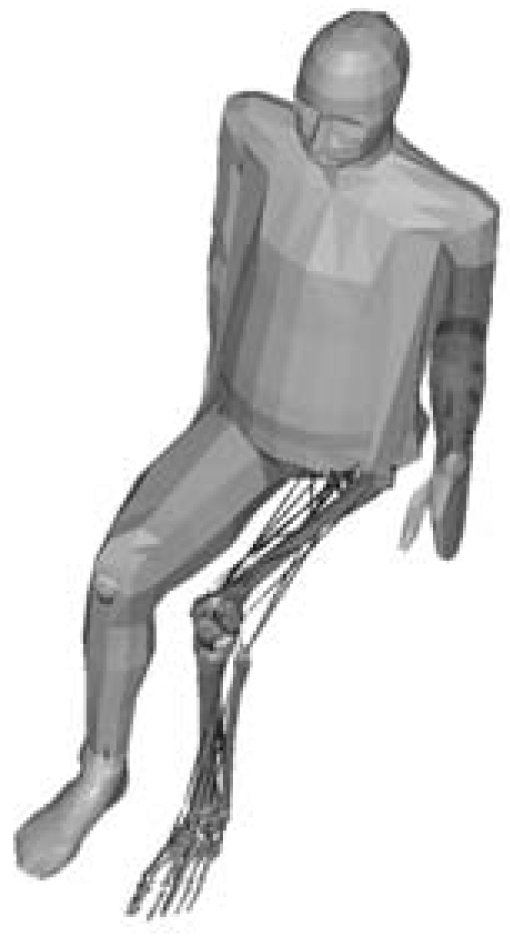
Multi-body musculoskeletal model representing a 50th percentile adult male.
Due to lack of overall musculo-sensory data measured for a bracing occupant, proportioning forces in every muscle group of the body is a nontrivial task. Implementing an inverse-dynamics based optimization routine is difficult in this situation since the external loading of the occupant is significantly complex, rigid-body and linear joint stiffness assumptions required for computational viability will affect the biofidelity of an injury-predicting model, and, finally energy based objective functions are yet to be validated for dynamic reflexive actions such as bracing. In the current study, a forward-dynamics based approach was used to drive the human model. To avoid developing a control system for every muscle group in the body, 12 major flexor and extensor muscle groups controlling the net moment at the ankle, knee, hip, and elbow joint were modeled and evaluated (Table 1). Modeling of muscle groups in the spine region and the shoulder joint was omitted due to complexities in geometric modeling of the muscle groups using simplified 1-D muscle representations (e.g., fanned fiber architecture of the deltoid muscles), and lack of accurate activation data necessary for estimating the muscle contraction forces. However, to improve the biofidelity of the head-neck dynamics of the braced occupant model, the inter-vertebral joint stiffness functions defined in the model were adapted to account for muscular contractions in the cervical spine region (R. Nightingale, personal communication, March 2008). Oi et al., (2004) reported on the maximum isometric net extensor, flexor, and lateral bending moments due to muscular contraction in each of the inter-vertebral cervical joints using a geometrically accurate FE model of the head/cervical spine complex. The bending moment stiffness due to maximum contraction expressed as a function of the flexion, extension and lateral bending angle for the C1 vertebrae-Occipital condylar (C1-OC) joint and the C7-T1 vertebral joint were determined from the results reported by Oi et al., (2004). Using the values of neck muscle loading sharing as a function of muscle tension [Chancey et al., 2003], the ordinates of the bending moment-angle stiffness curves representative of maximum contraction were scaled to represent moment-angle stiffness characteristics for a relaxed (unaware) and braced (aware) occupant.
Table 1.
Description of muscle groups considered in the study and their role in joint movement
| Flexors | Extensors | |
|---|---|---|
| Ankle Joint | Tibialis anterior Extensor digitorum longus | Gastrocnemius Soleus |
| Knee Joint | Biceps femoris Semitendonous Gastrocnemius | Rectus femoris Vastus intermedius |
| Hip Joint | Iliacus | Gluteus maximus |
| Elbow Joint | Biceps brachii | Triceps brachii |
Model Parameters
The vehicle model used in the study was a validated multi-body representation of the driver’s side interior compartment of a standard mid-size sedan car (shared by TASS-Safe™, Delft, Netherlands). The model included contact stiffness information for all subcomponents, detailed geometry information of the seat-structure, steering column, windshield and front-panel, and simplified representations of the side door, side window and the A-pillar. The vehicle restraint system included a FE model of the standard three-point belt system including a load limiting retractor, an adjustable D-ring system, a buckle system, and pretensioners at all belt anchor points, and a FE model of the standard airbag system.
The position of the seat-structure on the tracks relative to the steering column was determined using published regression equations describing occupant preferred seating position as a function of their stature and interior geometry of the vehicle [Flannagan et al., 1998]. The musculoskeletal occupant model was oriented in the driver seat based on nominal driving posture reported in the literature (Figure 3) [Schneider et al., 1983]. The initial positioning of the seat belt around the occupant body was performed by pre-tensioning the belt until the tensile force in the shoulder segment of the belt was 10N. To improve the feasibility of using the numerical model in parametric evaluations and optimization routines, an optimal time-step for the model was chosen based on the sensitivity of time-step to computational time and convergence of measured occupant responses such as contact forces and kinematic characteristics. An optimal minimum time-step of 1.5e–5s using Euler integration method resulted in a computational time of 375s to simulate a 300ms event.
Figure 3.
Multi-body model of a 50th percentile adult male occupant nominally seated in a standard mid-sized sedan car’s driver compartment.
Pre-collision Bracing Characteristics
Preliminary simulation of the occupant bracing behavior was performed using the muscle activation data reported in a published volunteer test study [Choi et al., 2005] and a standard emergency braking pulse of 0.7g’s [Reed & Keskin, 1987]. Due to differences in inertial, geometrical, and stiffness characteristics between the occupant model implemented by Choi et al., (2005) and the musculoskeletal model used in the current study, the reported levels of activation in different muscle groups produced unstable joint rotations during the post-bracing stage. The levels of activation in different muscle groups were thus optimized in the current study, to achieve a braced condition with dynamic equilibrium of the muscle forces across the joints evaluated in the study. The maximum activation levels for the 12 muscle groups were evaluated using the optimization routine, such that the net joint torques across the joints was minimized and the external loads measured at the hand-grip and foot-pedal interactions were constrained to a range of values recorded in the volunteer tests.
The optimization routine to evaluate optimal muscle activity was performed using commercially available software package, modeFRONTIER™ (v4, ESTECO s.r.l., Trieste, Italy), a design platform suited for multi-objective optimization. The design variables for the optimization routine were a set of variables corresponding to the maximum activity level in each muscle group (am). For each muscle group, the value of am was used to scale the normalized activation time history to obtain the actual activation time history. The normalized activation time history for each muscle group was obtained by normalizing the ordinates of the muscle activation time history determined by Choi et al., (2005) by their peak values. The optimization objective was formulated as overall minimization of net joint torques measured in the ankle, knee, hip, and elbow joint. An additional objective condition formulated as a constraint, was the minimization of average foot-pedal and hand-grip loads from the mean values of 151 N and 274 N, respectively, determined in the volunteer tests [Choi et al., 2005]. The initial population of the design variables was done using the Sobol algorithm by uniformly distributing the value of am for each muscle group in the range of 0.005 and unity. A standard multi-objective genetic algorithm, MOGA-II, was used to adapt the initial design populations over successive generations, and to determine optimal values for the am’s [Anderson, 2001]. Iterative trials yielded a setting of 20 initial designs, with 25 generations of design mutations to produce convergent solutions for the objective functions.
However, due to the over-constrained nature of the problem, multiple solution sets for the am’s were determined with the optimization routine. Using a standard physiologically based objective function defining the endurance based metabolic energy of the muscle groups, the values of am corresponding to minimum metabolic energy were determined. The objective function (u) for minimizing the metabolic energy is shown in Equation 1, where f and A are the tensile force and physiological cross-sectional area, respectively, of the ith muscle group, and n (reported value 3) is the exponent constant in the muscle endurance time–force relationship [Crowninshield & Brand, 1981].
| (1) |
The overall optimization routine shown in Figure 4 was used to determine the muscle activation time histories required for developing the muscle forces in a braced occupant under dynamic equilibrium during the pre-collision stage. In addition to the muscle activation levels corresponding to the external loading measured during the volunteer tests, intermediate bracing levels were determined by uniformly scaling the values of am for each muscle group. Hereafter the level of overall bracing will be denoted by the variable αb, with a value of 1 for the braced state corresponding to the optimized values of am and a value of 0 for the relaxed state (all am’s = 0.005).
Figure 4.
Overview of the optimization routine for determining muscle activation time history for braced occupants.
Sensitivity to Whole Body Injury Metric (WBIM)
Formulation of WBIM
The WBIM used in the study is a normalized representation of medical related cost and cost associated with lost quality of life due to the injuries. The WBIM relates the standard injury metrics estimated by an anthropometric tests device or a numerical human model to the overall harm associated with the injuries. The procedure for estimating the WBIM is outlined below.
Step 1: The musculoskeletal model was developed for numerically estimating the values of five standard injury metrics: head injury criterion (HIC), neck injury criterion (Nij), chest deflection (Cdisp), femur load (Feml) and tibial load (Tibl), during a collision pulse simulation.
Step 2: The probabilities of injuries at different severity levels and body regions were estimated using injury risk curves reported in the literature [Eppinger, 1999; Funk et al., 2001]. Using the values of injury metrics estimated in Step 1 and the corresponding injury risk curve for that body region, the probability of injuries in each severity category (Abbreviated Injury Scale (AIS) rating 1 to 6) were determined for the head, neck, chest, thigh and foot region.
Step 3: The medical and quality of life associated costs of injuries as a function of their severity and affected body region were determined using data reported in studies aimed at evaluating the social cost of motor vehicle collisions [Zaloshnja et al., 2004]. The formulation for whole body injury cost (WIC) is shown in Equation 2, where P(AISmn) is the probability of AIS level n injury in the body region m, determined in step 2, and MCmn and QLmn are the medical and quality of life associated costs for an victim with maximum AIS (MAIS) level n injury in the body region m, determined from the literature study.
| (2) |
Step 4: Due to approximations in cumulatively adding the costs associated with each injury, based on the estimated cost applicable for the MAIS injury, the procedure results in an overestimated value of WIC. To disregard any significance associated with the actual cost figure represented by WIC (step 3), the injury cost was normalized relative to the maximum and minimum possible values of injury cost estimates to obtain the normalized injury metric, WBIM.
Parametric Test Matrix for WBIM Sensitivity
Using the musculoskeletal model, the muscle activation time histories derived for different values of αb, and the formulation of WBIM, the sensitivity of WBIM to αb was analyzed. The kinematic pulse for evaluating the dynamics of a braced occupant in a frontal collision was divided into a low-severity (0.7g) deceleration pulse for activating all the muscle groups, and followed by a high severity (57 km/h, U.S. New Car Assessment Program (NCAP) frontal collision pulse) for the assessment of collision induced injuries. The positioning of the occupant in the vehicle compartment and initial orientation of the seat belt were done using methods described in the previous section. A generic load limiting value of 3000N and a pre-tensioning stroke of 120mm was used to model the restraint system, referred to as the standard restraint system in the study.
The values for WBIM, standard injury metrics, external loads, and whole body kinematics were evaluated for six values of αb in the range between 0 and 1, corresponding to relaxed, braced and four intermediate braced states.
Sensitivity to Restraint Performance
The effect of muscle bracing on the performance of a restraint system optimized for a passive occupant was evaluated by determining restraint properties optimized for occupants with different levels of bracing. Four restraint properties, seat belt load limiting value, pre-tensioner firing time, airbag firing time, and airbag vent discharge coefficient, were chosen as the design variables for the restraint system based on studies involving numerical analysis of adaptive restraint systems [Hesseling et al., 2006; Hou et al., 1995; Sieveka et al., 2001]. The model parameters for the musculoskeletal model and kinematic boundary conditions used for evaluating the restraint performance were identical to the conditions used while evaluating the sensitivity of WBIM to αb.
A direct search optimization algorithm was implemented using the multi-objective optimization software, modeFRONTIER™ (v4, ESTECO s.r.l., Trieste, Italy), to iteratively evaluate the values of the restraint properties resulting in the minimum value of WBIM, for constant values of αb. An initial range of values for the restraint properties was chosen based on values reported in the literature [Sieveka et al., 2001]. A deterministic algorithm, Sobol, was used to uniformly populate the values of restraint properties in the chosen initial range. The objective function of the optimization routine was formulated as minimization of WBIM, evaluated using Equation (2) and standard injury metrics estimated by the musculoskeletal model. Using the multi-objective genetic algorithm, MOGA–II, with an initial population of 10 designs adapted over 30 generations, the optimal restraint properties were evaluated for a relaxed and a braced occupant. The accuracy of the optimized design variables was improved by iteratively updating the range of restraint properties based on their sensitivity to WBIM.
Finally, the effect of muscle bracing on the injury outcome of an occupant was evaluated using restraint systems with three sets of properties. The first set of properties corresponded to the standard restraint system, the second set of properties was determined by optimizing the restraint performance for a relaxed occupant, and the final set of properties was determined by optimizing the restraint performance for a braced occupant. The correlation between WBIM and αb, and the variation in the range of WBIM and injury metric values was compared between the standard restraint system and the restraint systems with optimized properties. To analyze the requirements on the restraint properties to account for different values of αb, optimized values of restraint properties determined for the case with braced occupant were compared with the properties estimated by optimization for the relaxed occupant.
RESULTS
Pre-collision Bracing Characteristics
Muscle activation time histories for a braced occupant were determined using the optimization routine (Figure 4). The overall equilibrium for all the joints was indicated by the low values of net joint torques, produced by the 12 muscle groups in the musculoskeletal model using optimized values of am (Figure 5). The external loads (foot-pedal interaction and handgrip) estimated by the model under braced condition was within one standard deviation range of load limits reported in the volunteer test study (Figure 6).
Figure 5.
Net joint torques at the knee and ankle joint produced by muscle forces with activation time histories optimized with the external loading results reported by Choi et al., (2005). All the muscle groups were completely activated by 175 ms. The joint torques in the hip and elbow joint were less than 1 Nm and not shown in this figure.
Figure 6.
Comparison of foot-pedal forces estimated by the musculoskeletal model in braced and relaxed condition, to the average peak foot loads reported in the volunteer tests.
Sensitivity of WBIM to muscle activation
The kinematic trajectories of different body region due to variation in αb were reported in this study (Figure 7). In addition to kinematics, the effect of αb on the whole body dynamics of the occupant was evaluated by comparing the values of the standard injury metrics as a function of αb (Figure 8). The WBIM estimated in this study reported an increase in value from 0.266 to 0.300 as the bracing level (αb) was varied from 0 to 1 (correlation coefficient = 0.88). For assessment of harm due to injuries in different body regions, the relative contribution of each standard injury metric to the WBIM was evaluated as a function of αb (Figure 9). The difference in the maximum foot-pedal loads estimated for an occupant in relaxed and a braced condition was 360N.
Figure 7.
Kinematic trajectories for the head C.G., sternum, T10 vertebrae, and knee joint, estimated by the mid-sized adult maleoccupant adult male in relaxed and braced conditions, subjected to a standard frontal collision crash pulse.
Figure 8.
HIC, Nij, cdisp, feml, Tibl values estimated by the mid-sized adult male occupant model in a standard frontal collision, subjected to varying levels of pre-collision bracing. Bracing level value 0 and 1 corresponds to the relaxed and braced conditions, respectively.
Figure 9.
WBIM (the total vertical length of each bar) as a function of bracing level, αb, with the relative contribution of each body region to the WBIM (indicated by shaded blocks).
Sensitivity of Restraint Performance
The values of restraint properties optimized for relaxed and braced conditions were evaluated using the direct search optimization routine described earlier (Table 2). The subjective requirements on the restraint loading characteristics to take into account pre-collision bracing was analyzed by comparing the restraint load time histories of the restraint system optimized for a relaxed occupant to that for a braced occupant (Figure 10). The values of WBIM, HIC, Nij, cdisp, Feml, Tibl, estimated as a function of αb for a relaxed and braced occupant restrained by the standard restraint model were compared against the injury measures estimated for the relaxed and braced occupant restrained by a restraint model with properties optimized for a relaxed occupant (Table 3).
Table 2.
Mean values (standard deviation) of restraint properties optimized for a mid-sized adult male occupant, in relaxed and braced conditions, subjected to a standard frontal collision crash pulse. The pre-tensioner and airbag firing time are relative to the onset of the crash pulse.
| Relaxed | Braced | |
|---|---|---|
| Load limit (N) | 4381 (191) | 3816 (19) |
| Airbag vent discharge co-eff.(−) | 0.18 (0.08) | 0.38 (0.02) |
| Pre-tensioner firing time (ms) | 7 (2) | −1 (0) |
| Airbag firing time (ms) | −3 (2) | 2 (2) |
Figure 10.
Belt tension profile for an occupant in relaxed and braced states, restrained by a system with properties optimized to account for individual bracing levels.
Table 3.
WBIM and standard injury metrics measured for a relaxed and braced occupant restrained by the standard model and the restraint system with properties optimized for a relaxed occupant.
| Occupant models | Relaxed(αb=0) | Braced (αb= 1) | Δ% | |
|---|---|---|---|---|
| Standard restraint model | WBIM | 0.266 | 0.300 | 12.8 |
| HIC | 194 | 235 | 21.1 | |
| Nij | 0.303 | 0.293 | −3.3 | |
| Cdisp (mm) | 59 | 50 | −15.2 | |
| Feml (kN) | 5.911 | 8.621 | 45.8 | |
| Tibl (kN) | 6.338 | 7.568 | 19.4 | |
| Restraint model optimized for relaxed a occupant | WBIM | 0.249 | 0.293 | 17.7 |
| HIC | 157 | 197 | 25.5 | |
| Nij | 0.271 | 0.272 | 0.4 | |
| Cdisp (mm) | 60 | 52 | −13.3 | |
| Feml (kN) | 5.363 | 8.316 | 55.1 | |
| Tibl (kN) | 6.194 | 7.751 | 25.1 | |
DISCUSSION
The results of the study serve two purposes, first, to evaluate the sensitivity of overall harm and standard injury metrics to the level of pre-collision bracing and second, to demonstrate the influence of pre-collision bracing on the optimal performance of restraint systems. The muscle contraction forces required to maintain the dynamic equilibrium of the joints were determined using a forward dynamics based optimization routine. The severity of the estimated bracing corresponds to the external loads measured during the volunteer tests [Choi et al., 2005]. It should be noted that previous volunteer studies involving driving simulators and sled systems (e.g., Manning et al., 1997) have reported foot loads higher than the values used in the current study, suggesting that the level of bracing simulated in this study is a conservative estimate. The study focused on an experimental test with small size and controlled volunteer behavior, since the high variability in the foot loads (300N – 1300N) recorded by volunteers exhibiting reflexive bracing action limit the usefulness of the measured data for defining optimization objectives.
The kinematic trajectories, evaluated for the upper body (head C. G., sternum, T10 vertebrae) and lower extremity (knee joint) reference points, highlights the effect of pre-collision bracing on the magnitude of excursion in different body regions measured in the sagittal plane (Figure 7). Due to the forward excursion of the lower extremities into the knee bolster with increased level of muscle bracing, the lower extremity injury metrics: Feml and Tibl, reported a positive correlation, with respect to αb. Since the excursion of the upper body was constrained with the level of bracing was increased, a negative correlation was reported between Cdisp and αb.(Error! Reference source not found.). The magnitude and timing of peak linear acceleration values at the head center of gravity was consistent for different levels of bracing. However, due to artifacts in the head contact with the air bag, the impulse of head-airbag interaction and consequently the HIC was marginally higher for the braced occupant compared to the relaxed occupant.
The normalized injury metric, WBIM, proved effective in the holistic weighted comparison of the increased risk for lower extremity and head injuries and the decreased risk for chest injuries as the level of bracing and restraint properties were varied. As the restraint properties were optimized, the increased magnitude of restraining force resulted in higher differences in the injury metric values estimated for a relaxed and a braced occupant (Table 3). Therefore, the effect of pre-collision bracing on the overall injuries becomes more prominent for higher magnitudes of restraining forces.
All the restraint properties, except the airbag discharge coefficient, significantly affected the value of WBIM (correlation coefficients between 0.5 and 0.8). When the restraint properties were optimized for an occupant in relaxed and braced conditions, maximum variation was observed for the seat belt load limiting value and the pre-tensioner firing time. Comparing the seat belt restraining force time history for a restraint system optimized for a relaxed and a braced occupant, it could be concluded a restraining force-time profile with an earlier onset of restraining forces and lower peak threshold force would lower the overall risk of injury for a braced occupant (Figure 10). A reduction in the average restraint load and excursion distance applicable for a braced occupant highlights the role of muscle tension as effective energy management systems.
Current efforts in designing restraint systems have emphasized on the potential effectiveness of adaptive restraint by taking into account individual occupant properties [Cuerden et al., 2001]. While restraint designing has primarily focused on the physical properties such as anthropometric sizes and occupant bone mineral densities [Hardy et al., 2005], little effort has been directed towards reflexive occupant behavior such as muscle tension. Factors that have limited this consideration include the lack of means to characterize bracing behavior, high degree of variability in occupant responses, and significantly less research providing insight into this effect. The purpose of this study is to highlight the role of bracing dynamics and the kinematics of a braced occupant, in deciding restraint characteristics such as phasing of restraint deployments (e.g., airbags and pretensioners) as well as the magnitude of restraint loads. Preliminary results from optimization routines have been reported to emphasize the role of muscle tension as propriotonic restraint mechanisms, supporting the results regarding energy absorption potential of the braced occupant [Armstrong et al., 1968]. Although, the study is premature in providing guidelines for expressing optimal restraint properties as a function of occupant bracing, the role of muscle bracing in defining adaptive restraint response is nevertheless highlighted through the results.
The results obtained in the study were derived from a musculoskeletal model, which was primarily modeled for evaluating the response of lower extremity musculature. The development of the model lacks upper body musculature and complex muscle architecture was either simplified through 1-D representation or ignored in this study. The lack of lower spine musculature limits the ability to stabilize the model against inertial forces due to gravity. Such limitations introduce error in the initial kinematics of the occupant body in providing realistic occupant posture during the pre-collision phase. Future efforts in developing multi-body models intended for low-acceleration simulations, are focusing on controller based joint actuators capable of providing counter torques to maintain a pre-defined nominal posture of the body. The ability of such model to stabilize under low acceleration conditions and maintain an isometric braced condition in a dynamic collision pulse is yet to be developed. Additionally the scope of the current study is limited to a fixed value of occupant anthropometry, gender, age, and postural state. With additional data available for accurately estimating the bracing state of the occupant during the pre-collision phase, the influence of muscle bracing on the injury response could be extended to include the overall population.
CONCLUSION
The results of the study provide insight into the sensitivity of pre-collision muscle bracing by an occupant to the injury outcome during a collision. The evaluation of muscle response is further extended to provide information about requirements on the restraint system properties for minimizing overall injuries by taking into account the level of pre-collision bracing by the occupant. Such a framework for restraint characterization will improve the biofidelity of crash test devices and the design of optimal restraint system based on accurate and realistic pre-collision occupant characteristics. The methodology used in the study highlights the potential for optimization techniques coupled with experimental data to reduce occupant injuries by computationally extrapolating the volunteer response data to potentially injurious impact scenarios.
ACKNOWLEDGMENTS
The authors would also like to thank the AAAM endowment committee for supporting this work through sponsorship of the student grant award. Additionally, the authors would like to acknowledge the help provided by Dr. H. C. Choi, Hongik University, S. Korea, and S. Ejima, Japan Automobile Research Institute, Japan, regarding braced volunteer test data.
REFERENCE
- Anderson J. Multiobjective optimization in engineering design - application to fluid power systems. Linkoping University; Sweden: 2001. Doctoral dissertation. [Google Scholar]
- Armstrong RW, Waters HP, Stapp JP. Human Muscular Restraint during Sled Deceleration. Proc. Society of Automotive Engineers (SAE) World Congress, 680793; Warrendale, USA. 1968. [Google Scholar]
- Begeman P, King A, Levine R, Viano DC. Biodynamic response of the musculoskeletal system to impact acceleration. Proc. SAE World Congress, 801312; Warrendale, USA. 1980. [Google Scholar]
- Chancey VC, Nightingale RW, Van Ee CA, Knaub KE, Myers BS. Improved estimation of human neck tensile tolerance: reducing the range of reported tolerance using anthropometrically correct muscles and optimized physiological initial conditions. STAPP Car Crash Journal. 2003;47:135–153. doi: 10.4271/2003-22-0008. [DOI] [PubMed] [Google Scholar]
- Choi YH, Sah JS, Lee B, Cho SH, Kang JS, et al. Experimental and numerical studies of muscular activations of bracing occupant. Proc. 19th International Technical Conference on the Enhanced Safety of Vehicles (ESV), 05–0139; Washington DC, USA. 2005. [Google Scholar]
- Crandall JR, Kent RW, Viano D, Bass CR. The Biomechanics of Inflatable Restraints - Occupant Protection and Induced Injury. In: Kent R, editor. Air Bag Development and Performance. Warrendale: Society of Automotive Engineers; 2003. pp. 69–110. [Google Scholar]
- Crowninshield RD, Brand A Physiologically Based Criterion of Muscle Force Prediction in Locomotion. J. Biomechanics. 1981;14(11):793–801. doi: 10.1016/0021-9290(81)90035-x. [DOI] [PubMed] [Google Scholar]
- Cuerden R, Hill J, Kirk A, Mackay M. The potential effectiveness of adaptive restraint systems. Proc. IRCOBI conference; Isle of Man, UK. 2001. [Google Scholar]
- Delp SL, Loan JP, Hoy MG, Zajac FE, Topp EL, et al. An interactive graphics-based model of the lower extremity to study orthopaedic surgical procedures. IEEE Trans. on Biomedical Engineering. 1990;37:757–767. doi: 10.1109/10.102791. [DOI] [PubMed] [Google Scholar]
- Ejima S, Ono K, Holcomb S, Kaneoka K, Fukushima M. A Study of Occupant Kinematics Behavior and Muscle Activities during Pre-impact Braking Based on Volunteer Tests. Proc. International Research Council on Biomechanics of Impacts (IRCOBI) conference; Maastricht, Netherlands. 2005. [Google Scholar]
- Eppinger EA. Development of improved injury criteria for the assessment of advanced automotive restraint systems -ii, Technical report. National highway traffic safety administration (NHTSA); 1999. [Google Scholar]
- Flannagan CAC, Manary MA, Schneider LW, Reed MP. An improved seating accomodation model with application to different user populations. Proc. SAE World Congress, 980651; Warrendale, USA. 1998. [Google Scholar]
- Funk JR, Crandall JR, Tourret LJ, MacMohan CB, Bass CR, et al. The effect of active muscle tension on the axial injury tolerance of the human foot/ankle complex. Proc. International Technical Conference on the Enhanced Safety of Vehicles, 237; Amsterdam, Netherlands. 2001. [Google Scholar]
- Hall GW. Biomechanical characterization and multibody modelling of the human lower extremity. University of Virginia; Charlottesville, USA: 1998. [Doctoral dissertation]. [Google Scholar]
- Happee R, Hoofman M, Kroonenberg VDAJ, Morsink P, Wismans J. A Mathematical human model for frontal and rearward seated automotive impact. Proc. 42nd Stapp car crash coneference, 983150; Tempe, USA. 1998. [Google Scholar]
- Hardy RN, Watson JW, Frampton R. Development and Benefits of a Bone Scaning System. Proc. International IRCOBI Conference on the Biomechanics of Impact; Prague, Czech Republic. 2005. [Google Scholar]
- Hesseling RJ, Steinbuch M, Veldpaus FE, Klisch T. Feedback control of occupant motion during a crash. Int. J. Crashworthiness. 2006;11(1):81–96. [Google Scholar]
- Hou J, Tomas J, Sparke L. Optimization of driver-side airbag and restraint system by occupant dynamics simulation. Proc. SAE World Congress, 952703; Warrendale, USA. 1995. [Google Scholar]
- deLange R, vanRooij L, Mooi H, Wismans J. Objective biofidelity rating of a numerical human occupant model in frontal to lateral impact. Stapp Car Crash Journal. 2005;49:457–479. doi: 10.4271/2005-22-0020. [DOI] [PubMed] [Google Scholar]
- Manning P, Wallace WA, Roberts AK, Owen CJ, Lowne RW. The position and movement of the foot in emergency manoeuvres and the influence of tension in the achiles tendon. Proc. SAE World congress, 973329; Warrendale, USA. 1997. [Google Scholar]
- National Highway Traffic and Safety Administration (NHTSA) 2004. Retrieved from FMVSS regulations summary at http://www.nhtsa.dot.gov/cars/rules/-standards/FMVSS-Regs/index.htm, 2004.
- Oi N, Pandy MG, Myers BS, Nightingale RW, Chancey VC. Variation of neck muscle strength along the human cervical spine. STAPP car crash journal. 2004;48 doi: 10.4271/2004-22-0017. [DOI] [PubMed] [Google Scholar]
- Ore LS. Design requirements and specifications: dummy lower extremity development task, Event Report. NHTSA; 1992. [Google Scholar]
- Reed WS, Keskin AT. Vehicular response to emergency braking. Proc. SAE World Congress, 870501; Warrendale, USA. 1987. [Google Scholar]
- Schneider LW, Robbins DH, Pflug MA, Snyder RG. Development of anthropometrically based design specifications for an advanced adult anthropomorphic dummy family. Vol. 1. University of Michigan Transportation Research Institute; 1983. Technical Report. [Google Scholar]
- Sieveka EM, Kent RW, Crandall JR. Comparisons of seat belt force-limiting methods using the madymo multi-body/finite element program. Proc. 45th Annual Procedings Association for the Advancement of Automotive Medicine; Chicago, USA. 2001. [PubMed] [Google Scholar]
- TNO, Madymo, Human models manual. version 6.3.2, 2006, TNO MADYMO BV..
- Zaloshnja E, Miller T, Romano E, Spicer R. Crash costs of body part injured, fracture involvement, and threat-to-life severity, united states -2000. Accident Analysis & Prevention. 2004;36:415–427. doi: 10.1016/S0001-4575(03)00035-6. [DOI] [PubMed] [Google Scholar]



